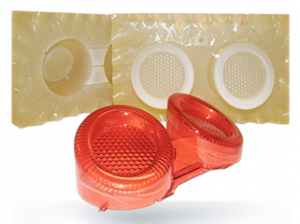Vacuum casting or vacuum duplication involves injecting a resin into a silicone mold. Because of its cost and deadline, this method is most suited to pre-series, with a faithful reproduction of the original model and a result close to the end result in the “right material”. Vacuum casting technology is recommended for the production of around ten to one hundred parts for mechanical or visual tests.
Advantages of vacuum casting
- High precision, fine detail: the silicone mold makes it possible to obtain parts totally faithful to the original model, even with the most complex geometries. The result is perfect, with quality comparable to the final part.
- Quality of the part: the use of resins allows you to choose a material as close as possible to the right material, with a wide choice of hardnesses: flexible or rigid, but also the final appearance: the part can be colored in the mass or else have a ‘crystal’ type transparency. It is also possible to create overmoldings (for example with brass inserts) and produce painted finishes.
- Prices and deadlines: the use of silicone for the mold allows a reduction of costs compared to an aluminum or steel molds. In addition, you can achieve economies of scale from around ten parts, which makes this method more valuable than 3D printing. Finally, it takes 7 to 10 days to get 30 to 50 functional prototype parts, making it an attractive method to meet urgent needs.
Limits of vacuum casting
- The lifetime of the mold: the silicone mold has a shorter lifetime than an injection mold, and the tool thus created can produce only a few dozen parts.
- Installation: due to the need to have an original model and create a silicone mold, this method requires a small investment, in contrast to 3D printing or stereolithography. Nevertheless, this investment becomes an advantage thanks to economies of scale as soon as more than 5 to 10 parts have to be produced.
Preferred uses of vacuum casting
For all the reasons mentioned above, vacuum casting is recommended for:
– pre-series to test the market with your customers
– pre-series for certification
– pre-series for mechanical or aesthetic validation in marketing and design.
– small series for the first commercialization
To learn more about this rapid prototyping technology, read the answers to our workshop leader on vacuum casting.


Comments (2)
Typically, how many shots can you get out of a vacuum casted mold. In a ABS type material.
Thank you
Hello Mike,
Many thanks for your comment,
You can get at least 20 shots out of a silicon mold.
After 20 shot, the vacuum casted mold starts to decrease in quality.
Have a great day,
The Prototech Team